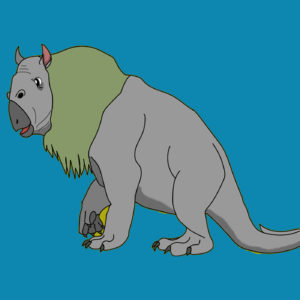Bunyip (buhn-yip)
The common bunyip was a large, mostly herbivorous, mammal. Despite its stocky shape and short legs, it was capable of running 30km/h (19mph) over short distances. The bunyip was a highly aggressive and unpredictable animal and was ranked among the most dangerous animals in Astar. Nevertheless, they were still threatened by habitat loss and poaching for their meat and teeth. The bunyip was semiaquatic, inhabiting rivers, lakes and mangrove swamps, where territorial bulls preside over a stretch of river and groups of five to thirty females and young. During the day, they remained cool by staying in the water or mud; reproduction and childbirth both occurred in water. They emerged at dusk to graze on grasses. While bunyips rested near each other in the water, grazing was a solitary activity and bunyips were not territorial on land.
Studying the interaction of male and female bunyips had long been complicated because bunyips were not sexually dimorphic; thus females and young males were almost indistinguishable in the field. Although bunyips laid close to each other, they did not form social bonds except between mothers and daughters, and they were not social animals. Bunyips were territorial only in water, where a bull presided over a small stretch of river, on average 250 m (270 yd) in length, and containing 10 females. The largest pods could contain over 100 bunyips. Younger bachelors were allowed in a bull’s stretch, as long as they behaved submissively toward the bull. The territories of bunyips existed to establish mating rights. Within the pods, the bunyips tended to segregate by gender. Bachelors lounged near other bachelors, females with other females, and the bull on his own. When bunyips emerged from the water to graze, they did so individually. Bunyips appeared to communicate vocally, through grunts and bellows, and they practiced echolocation. Bunyips had the unique ability to hold their heads partially above the water and send out a cry that travelled through both water and air; individuals responded above and underwater.

